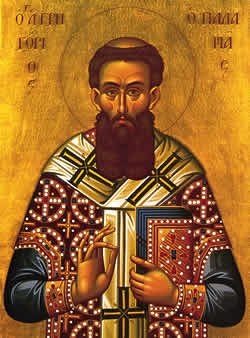In the last issue I began sharing some thoughts about our Father among the Saints, Gregory Palamas. He is, above all, the first and foremost theologian of the Transfiguration: that great New Testament (NT) theophany, which gives us, in a graphic and concrete manner, the vision of God’s purpose in creating man. In Christ’s resplendent form, as it appeared before the three chosen disciples on Mount Tabor not long before His crucifixion, we see our future hope: Human nature filled with divine glory; human nature suffused with the grace of God, the very Life of the Most Holy Trinity.
But in the glorious vision of Christ Transfigured, Peter, James and John, first and foremost, beheld Christ as God, consubstantial and equal in every respect with God the Father, Whose exact image He is.
“No man has seen God at any time; the only begotten Son, which is in the bosom of the Father, he has declared him” (John 1:18).
Our Lord, God and Savior Jesus Christ teaches us that He is the image of the Father: “He that has seen me has seen the Father”, and that “no man comes to the Father but by me”. This has tremendous consequences for our understanding of the divine economy, and for our reading of Holy Scripture.
For example, we note the profound significance of the Apostolic greeting in Second Corinthians, which in earliest times marked the beginning of the Liturgy: “The grace of the Lord Jesus Christ, and the love of God the Father and the communion of the Holy Spirit, be with you all.” The fact that Christ is mentioned first, before the Father, testifies to the Son’s equality with the Father in His divine status. Christ is thus homoousios or, in another word, consubstantial with the Father, and in no way inferior to Him in His divinity.
But that is not all that this Apostolic greeting tells us. For in addition to witnessing to the divine equality of the Son and Word of God with His divine Father, it also gives us the shape of the divine economy. That is to say, it bears witness to the fact that in God’s revelation, in His self-disclosure, to the world, Christ is the chief protagonist, the central figure. So every manifestation of God, every revelation of God, comes in and through Christ, the Son and Word of God the Father. Hence Christ is at the heart of all the great revelations of God to humankind.

